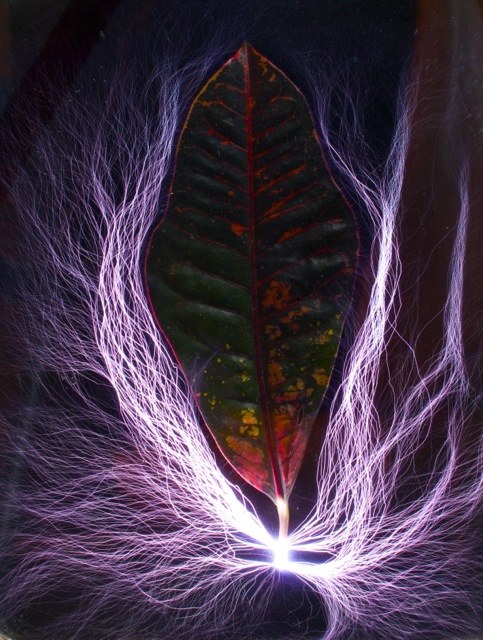Category Archives: art
Controlling Lightning Morphology around and within the Same Flower during Kirlian or High voltage Photography
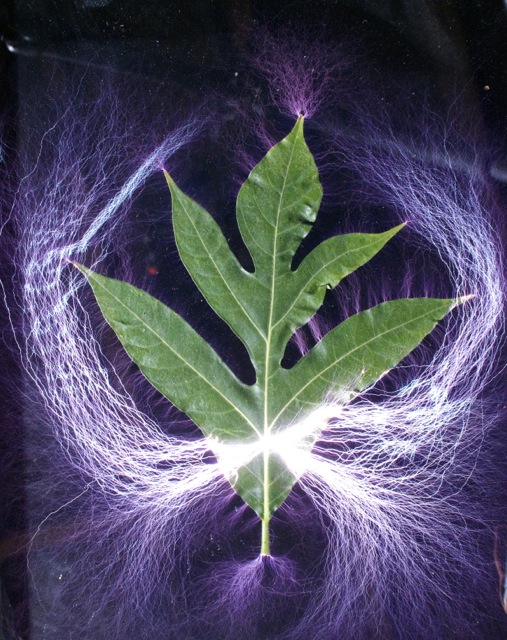
I’ve been home for but a week, and tomorrow I set out on a grand adventure of driving crosscountry in wintertime for a yet grander adventure as an artist in residence at the incomparable Autodesk Pier-9 workshop. Before I go though, I wanted to upload a few of the digital test shots I made while in hawaii this last month, shooting “Electrified Flowers (and leaves) of Hawaii“.
These were off the cuff test shots – throw-aways – done to check my exposure, check the electrical apparatus, and visualize the pattern of branching lightning that I might be about to record onto expensive 20-square-inch large sheets of silver halide and color film. These are not the final products of my project, rather mere teasers of work-in-progress. (I have yet to develop that film, which I’ll do once I can settle into San Francisco.) However, I’m pretty ecstatic with the results, sofar!
One of the most exciting learning discoveries for me during this work is that I can significantly control whether lightning issues radially from the leaf, or tangentially skirting around it, or some mix between the two. I’m looking forward to making an excellent explanation of how this works, both practically and in detailed physical terms. It will probably be a chapter of the book I’m working on, “Theory and Practice of High Voltage Photography”.
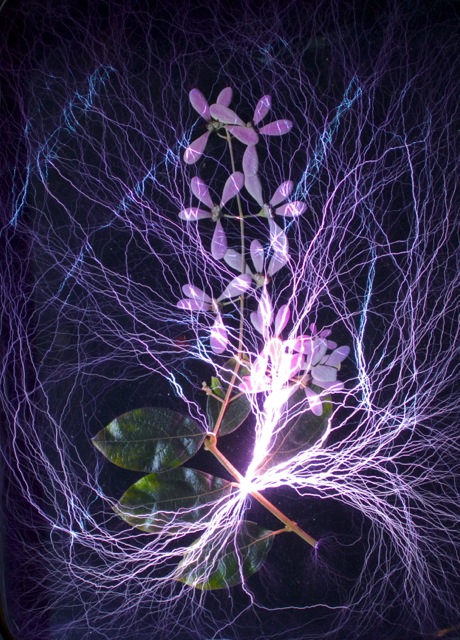
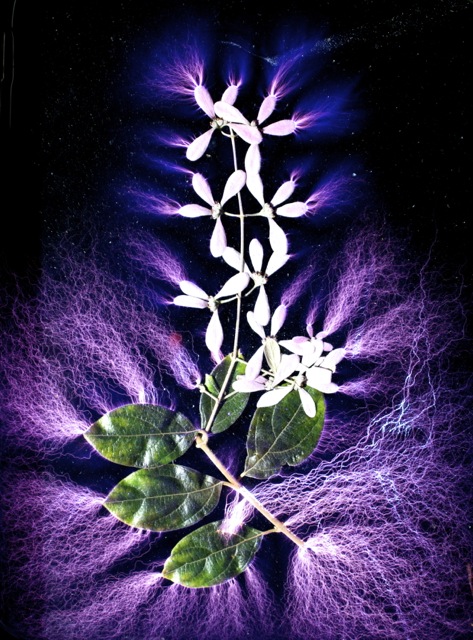
“Electrified Flowers of Hawaii” Kickstarter succeeds at 227%
The “Electrified Flowers of Hawaii” project succeeded in raising more than twice it’s initial funding goal! Consequently I am now in Hawaii where, for the next month, I will be studying the floral biodiversity of the Big Island using a large format film camera and apparatus I built myself, including a lightning machine (a Marx generator) capable of producing intense pulses of electricity at up to a quarter million volts.
Gordon Kirkwood selected as Artist in Residence at Autodesk’s Pier-9 Dream-lab.
“Giddy” cannot begin to describe my feelings upon learning, on Thanksgiving, that I have been selected to be an Artist In Residence at Autodesk’s Pier-9 dream-lab in San-Francisco.
The concentration of brains, initiative, creativity, and capability in that space is stunning. In close approximation to Tony Stark’s workshop (from the movie Iron-Man) — a dream-shop with some of the most capable robotic fabrication equipment and tooling in existence including 3D printers, water-jets, lasers engravers powerful enough to work with metal, multi-axis milling machines, and more — it goes far beyond simple awesome tooling to be, from what I gather, a collegiate atmosphere where everyone is extraordinarily motivated to learn, make, and do things that push the limits of creativity, and in a context where the expected norm is to share and disseminate knowledge through the Instructables knowledge sharing website platform. Buzz Aldrin (Astronaut of Apollo XI moon-landing fame and the second person to walk on the moon after Neil Armstrong) was hanging out there testing a functioning magnetic repulsion hoverboard a few weeks ago, for instance. To be included in the cohort of selected artists for 2015 is a huge honor and inspires me to the grandest ambitions. Thank you, universe. Thank you, Noah. Thank you, Vanessa. Thank you, Mary. Thank you, Karen.
PIER 9 AiR PROGRAM from Pier 9 on Vimeo.
Computer Controlled Variable Aperture Soap Film Iris – First Bubbles!
I’m fascinated with ephemeral phenomena, and the most recent manifestation of this has led me to invent some elaborate technical apparatus to make photographs of huge bubbles doing interesting things. Here are two videos of it working for the first time- the first with a series of close-up views of different components, the second as a wide-view of the whole system in operation.
Giant bubbles are uniquely able to engage and delight people of all types. Who can resist feeling wonder and awe at giant, floating, opalescent, undulating transparent orbs and the salience they give to normally invisible 3-dimensional flows? After my first experience blowing bubbles from a moving bicycle (the wind past the bicycle removes any requirement to blow or move the wand, you just adjust your speed to get the right wind), I was hooked.
I’ve organized a number of bubble blowing events, especially the “Bubbles on Bikes Jamboree Ride” for Bike Pittsburgh’s Bikefest and the first ever “Giant Bubbles Flash Mob”. For the latter, I manufactured 45 giant bubble wands, and about 25 gallons of giant bubble juice, and coordinated a synchronized release of ridiculously many insanely huge giant bubbles. Beyond the pre-arranged 45 bubble blowers, we had the fully invested attention and participation of somewhere between 300 and 500 people for several solid hours. All for about two days prep and maybe $200 in materials (including the pizza for the wand-making party). See the nicely polished video made by Ben Saks of Float Pictures here, or the great single-take cellphone video clip from Jason Kirin here.
For some things I’d like to do, I required a highly repeatable way of producing bubbles, and controlling aspects like timing and size and speed and direction. I also love a good engineering challenge, and so I invented a cable iris aperture mechanism and set out to use it to make a uniquely flexible and useful bubble machine. A CNC bubble machine.
There’s a few very sophisticated things I’d like to do with this which I’ll write about later, but for the first project I’m looking forward to making playful occupational portraits of some friends, mentors, and elders I feel lucky to know and learn from. I’m fortunate to have a few such in my life, in their sixties, seventies and eighties, and who in addition to great technical accomplishments, embody wonderful spirits of playfulness and creativity in their golden years that it’d be my pleasure to honor and record with such portraits.
Animated Retroreflective Safety Signage
I’ve been playing with a new process in which I remove the silvering of mirrors in detailed patterns, leaving optically clear glass.
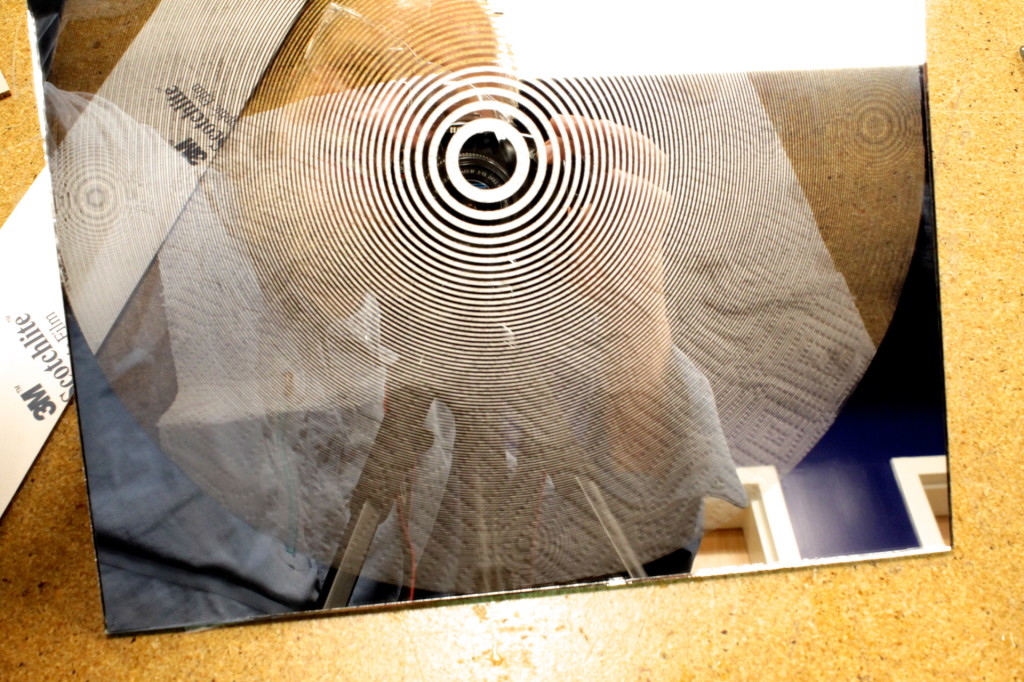
My first experiment was to make a Zone Plate, but my current process didn’t have enough resolution to make fine enough lines for a zone plate of short focal length at normal visible wavelengths around 600nm:
However, the process is fantastic for barrier grid a.k.a. moiré a.k.a. ‘strip’ animations, and for an afternoon project this has borne incredible fruit: only about a dozen promising directions to go from here! I decided to focus first on making an animated cautionary text and moving image safety sign for vehicles, especially bicycles, especially helpful for night-time visibility.

